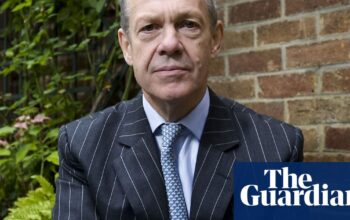As a child, Raymond Goodchild felt like the 25-mile stretch of road between Terrace Bay and Pays Plat First Nation in northern Ontario represented two completely different worlds.
During the 1960s, Terrace Bay was frequently enveloped in a dense smoke emanating from pulp mills. Similar to many other regions in postwar Canada, the economy prospered and employment opportunities were abundant. Infrastructure such as roads and sidewalks were constructed and residences were illuminated at night with electricity.

Goodchild’s home in Pays Plat, meanwhile, was a tar-paper shack without electricity or running water, which would whistle with cold drafts at night. The division of the world seemed clear – and Goodchild and other Indigenous people were on the wrong side. He was taunted at school. He survived bitter winters with only a thin denim jacket. He often picked through the local garbage dump for anything useful. It took two decades before he had a home with running water. He had to enlist in the Canadian military before he ever experienced the feeling of bedsheets.
“When my daughter was born, I prayed for the opportunity to provide her with a better life.”

Over 170 years ago, a treaty was made between the Crown and Goodchild’s ancestors, guaranteeing them a portion of the region’s wealth. However, instead of receiving their promised share, his community has been plagued by health issues, poverty, and a lack of adequate housing. This is a lasting consequence of the colonial project initiated by the British government and carried on after Canada’s independence.
Twelve Indigenous communities in northern Ontario have been deprived of a standard of living that is enjoyed by the rest of society, despite the fact that these communities were supposed to receive resources from the government. This could have significant implications for both the communities and Canada as a whole, as a court is considering awarding them with a large sum of money to compensate for unpaid rent.
Goodchild, who is now 67 and holds a position of high regard in his community, acknowledges that certain improvements have been made, such as the widespread availability of running water and electricity. However, despite assurances made over the years, poverty continues to afflict Pays Plat, worsened by issues such as drug addiction and mental health problems.
“I am patiently awaiting the promised truth and reconciliation, but so far it remains elusive,” stated the ex-chief and highly decorated military veteran.

Every day, Goodchild walks by the lichen-covered wooden crosses that mark the graves of his parents. These crosses are located just a few dozen feet away from the Pays Plat River, which runs through the community and flows into Lake Superior.
The spirits of my ancestors, along with those who have been laid to rest here, are always with me. They observe and witness my efforts to make a positive impact in this world.

For many years, understanding the land and water in this area has been crucial for those who live here, as it can be both a source of abundance and harsh conditions. The Anishinaabe people used a 13-month cycle to track the seasons and plan their harvest. At the end of summer, during the moon of falling leaves, they would gather fiddleheads and sweetflag in abundance. Three moons later, they would hunt caribou for their meat. This knowledge was a fundamental aspect of mino-bimaadiziwin, the Anishinaabe belief in living a fulfilling life.
According to community leaders, for a significant amount of time, broken pledges have resulted in generations being deprived of the chance to experience mino-bimaadiziwin.
In 1850, various Anishinaabe groups residing near Lakes Huron and Superior entered into a treaty with the British Crown, covering an area of 35,700 square miles. Referred to as the Robinson Treaties in honor of fur trader William Robinson, who represented the Crown in negotiations, these agreements recognized the Indigenous communities’ entitlement to hunt and fish.

Robinson was aware that the Crown had limited funds to invest in the area. In order to address this issue, he proposed a unique solution. He added a provision called the “augmentation clause” which would periodically increase the annual payments based on the amount of wealth generated from the land. Furthermore, this increase would only occur if it did not result in a loss for the Crown.
For the next 173 years, the agreement brought in significant profits for businesses and the province of Ontario from the covered lands and waters. However, the payments to individuals were limited to $4 per person in 1874 and were never raised.
The industry and towns in the area prospered, while the First Nations communities were neglected and living in poor conditions. They were also subjected to strict laws, such as being forbidden to hire a lawyer or leave their reserves without government approval.
In 1998, leaders from communities involved in the Robinson-Superior treaty filed a lawsuit against the government, claiming that it had failed to fulfill its commitment to distribute the resources of the land.
The legal case progressed slowly through the judicial system and twenty years later, a judge ruled in their favor.
In a ruling from 2018, Patricia Hennessy, a superior court justice in Ontario, determined that the “honour of the Crown” had been significantly diminished as a result of various governments failing to keep their promises.
Hennessy exerted effort to comprehend the Anishinaabe viewpoint, actively engaging in sweat lodge rituals, pipe ceremonies, sacred fire teachings, smudge ceremonies, and presentations involving eagle staffs and feathers alongside her legal teams.
She went against the common belief that Indigenous peoples were tricked into unfair deals or unknowingly gave up their land. According to Hennessy, the Anishinaabe were fully aware that they were transferring their land to the Crown for development and settlement. She stated that they considered it a valuable gift, as the land and water held significant meaning for their ancestors and represented the essence of life.
They did this with the belief that the agreement would be respected.
The 12 countries involved in the Robinson Superior treaty are currently demanding considerable reparation. According to Nobel Prize-winning economist Joseph Stiglitz, the amount could potentially reach C$126 billion.
During his testimony in February, he stated that owing someone something for 170 years accumulates to a significant amount of money.
However, Ontario has rejected these claims and maintains that instead of becoming wealthier, it has actually invested approximately C$4.2 billion in its endeavors to develop the northern region and make it accessible to businesses.
The ongoing legal fight serves as a powerful reminder of unfulfilled commitments for the countries bordering Lake Superior.
Marcus Hardy, leader of the Red Rock First Nation, questioned the potential number of individuals who could have been spared if they had access to adequate healthcare, suitable housing, clean water, and necessary medication. He emphasized that the issue goes beyond financial compensation and encompasses the decline of their rights and the hindrance of their community’s well-being.


The recently constructed butcher shop at the nature reserve displays a bull moose suspended on a metal rack. The hunter and their loved ones will soon carefully disassemble and divide the large amount of meat into smaller portions.
Created to combat a food sovereignty emergency, this store combines traditional expertise with contemporary conveniences. As part of the autumn harvest, younger hunters contribute moose meat to the elders, while the community holds a food donation event for individuals who are facing difficulties in purchasing groceries.

The earnings of those living on reserves are significantly lower compared to other areas, and the percentage of indigenous children living in poverty remains consistently high. Children on reserves receive less funding for their education compared to those in nearby towns, and a report from Canada’s auditor general revealed that only 24% of students were able to finish high school within four years between 2011 and 2016. Access to basic healthcare services, such as doctors and dentists, is often limited.
The Canadian government acknowledges that their efforts to forcibly assimilate Indigenous peoples and relocate First Nations to uninhabitable reserves have led to shorter lifespans, poverty, and illness.
While traveling through the Red Rock reserve, surrounded by lush forests of fir, spruce, and birch, Hardy acknowledges the pervasive impact of Canada’s discriminatory policies outlined in the Indian Act on the community’s daily experiences.
According to Hardy, a former member of the Canadian military who completed two deployments in Afghanistan, it was difficult to come to terms with the way his nation treated his community despite his dedication to serving it.
During WWI, Canada took control of large tracts of reserve land, displacing Indigenous peoples. The government redistributed this land to non-Indigenous veterans through a farming program, without including Indigenous communities.
Indigenous veterans frequently encountered institutionalized prejudice, including a clause stating that any individual of Indigenous descent who was away from their reserve for four consecutive years would forfeit their legal recognition. As a result, many Indigenous veterans returned home only to discover that the government had stripped them of their rights. Due to the restrictions of the Indian Act, some Indigenous men relinquished their status to be able to visit a Royal Canadian Legion establishment.
“After serving. Just to go have a couple of drinks,” said Hardy. “It’s insane the atrocities they went through. It was a complete human rights violation. And it lasted for years.”
Although there have been modifications to those regulations, the Indian Act still perpetuates disparities. The Crown holds all reserve land, meaning that residents do not have ownership of the land beneath their homes and are unable to use it as collateral for entrepreneurial ventures or to secure loans.

Juanita Starr, who lives 130 miles east of Pays Plat in the Biigtigong Nishnaabeg community, reflects on the potential for a significant settlement and how it serves as a stark reminder of how the lives of past generations could have been vastly different. The journey to her community involves passing through a corridor of basalt cliffs and stunning tamarack trees.
Although her grandfather possessed an entrepreneurial mindset, the limited resources in his community hindered the realization of his ambitious dreams such as owning a solar farm.
Starr, the sustainable development director for the community, reflects on how receiving this sum of money over the years would have affected them.
As her two young offspring mature, the prospect of a considerable sum has altered her perspective on future generations.
She wondered how we can plan for their future and ensure that they are prepared, for example, if my son wants to attend Harvard Law School or Trinity College.
Justice Hennesy must now decide on appropriate compensation for the nations after receiving input from chiefs and elders, including Raymond Goodchild. The province of Ontario has stated that this responsibility should not fall on the courts, but the First Nations have disagreed with this argument.
Brian Gover, a lawyer representing seven First Nations, stated that if they are not receiving fair treatment from the government, they have to seek help from the courts. While some may argue that the court system is not the best way to handle issues of compensation, especially concerning treaty rights, we rely on it regularly for intricate damage assessments in order to obtain justice for those who have been wronged. It seems insincere to suggest that Indigenous people should instead rely on other processes that have proven to be unsuccessful.
Community leaders see the case as a matter of fundamental fairness.

Wilfred King, chief of Gull Bay, expresses hope for a resolution that will lift his people out of poverty and allow them to thrive as First Nations on their rightful territory. He acknowledges the historical injustice of the “Doctrine of Discovery” and the legal system that allowed for the unjust taking of Aboriginal lands.
The monarch views the potential for a noteworthy agreement as an opportunity to tackle the community’s most urgent requirements: constructing homes, medical and mental health facilities. Gull Bay, located on the rugged coast of Lake Nipigon, 120 miles north of Thunder Bay, requires updated water and sewer systems, as well as paved roads and the potential for sidewalks. King has cautiously begun envisioning permanent dentists and doctors within the community, and perhaps even a cooperative grocery store.

King stated that the future holds great possibilities, and by resolving these claims and asserting our rights, development will only happen with the collaboration of First Nations and industries. He emphasized that when we triumph, it benefits everyone.
Source: theguardian.com


